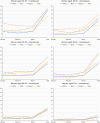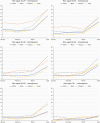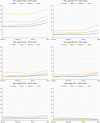Disparate Disruptions: Intersectional COVID-19 Employment Effects by Age, Gender, Education, and Race/Ethnicity
- PMID: 33214905
- PMCID: PMC7543645
- DOI: 10.1093/workar/waaa013
Disparate Disruptions: Intersectional COVID-19 Employment Effects by Age, Gender, Education, and Race/Ethnicity
Abstract
These are unprecedented times, as the COVID-19 pandemic disrupts public health, social interaction, and employment attachments. Evidence to date has been about broad shifts in unemployment rates as a percent of the labor force. We draw on monthly Current Population Survey data to examine subpopulation changes in employment states across the life course, from January through April 2020. COVID-19 downturns produced disparate life-course impacts. There are increases in unemployment and being out of the workforce at all ages, but especially among young adults, with young women most at risk. Intersectional analyses document conjoint life-course vulnerabilities by gender, educational attainment, and race/ethnicity. For example, Black men aged 20-29 with a college degree experienced a 12.4 percentage point increase in being not in the labor force for other reasons (NILF-other). Individuals with less than a college degree in their 50s and 60s were more likely to become unemployed, regardless of race. And more non-college-educated Asian men in their 60s and 70s reported being retired (6.6 and 8.9 percentage point increases, respectively). Repercussions from the pandemic may well challenge assumptions and possibilities for older adults' working longer.
© The Author(s) 2020. Published by Oxford University Press. For permissions please e-mail: journals.permissions@oup.com.
Figures







Similar articles
-
The Uneven Later Work Course: Intersectional Gender, Age, Race, and Class Disparities.J Gerontol B Psychol Sci Soc Sci. 2022 Jan 11;77(1):170-180. doi: 10.1093/geronb/gbab039. J Gerontol B Psychol Sci Soc Sci. 2022. PMID: 33687059 Free PMC article.
-
Demographic aspects of unemployment in Jordan.Egypt Popul Fam Plann Rev. 1979 Jun-Dec;13(1-2):29-83. Egypt Popul Fam Plann Rev. 1979. PMID: 12312264
-
An Intersectional Analysis of COVID-19 Unemployment.J Econ Race Policy. 2020;3(4):270-281. doi: 10.1007/s41996-020-00075-w. Epub 2020 Dec 15. J Econ Race Policy. 2020. PMID: 35300201 Free PMC article.
-
An economic analysis of female work participation, education, and fertility: theory and empirical evidence for the Federal Republic of Germany.J Labor Econ. 1985 Jan;3(1 Part 2):S218-34. doi: 10.1086/298082. J Labor Econ. 1985. PMID: 12146348
-
Transgender Men and Women in 2015: Employed, Unemployed, or Not in the Labor Force.J Homosex. 2021 Jan 28;68(2):203-229. doi: 10.1080/00918369.2019.1648081. Epub 2019 Aug 12. J Homosex. 2021. PMID: 31403900
Cited by
-
The Age of Satisficing? Juggling Work, Education, and Competing Priorities during the COVID-19 Pandemic.Socius. 2022 Jan-Dec;8:10.1177/23780231221088438. doi: 10.1177/23780231221088438. Epub 2022 Mar 25. Socius. 2022. PMID: 38344114 Free PMC article.
-
COVID-19 and Gender Gaps in Employment, Wages, and Work Hours: Lower Inequalities and Higher Motherhood Penalty.Comp Econ Stud. 2022 Aug 11:1-23. doi: 10.1057/s41294-022-00198-z. Online ahead of print. Comp Econ Stud. 2022. PMID: 35971561 Free PMC article.
-
Negative Employment Changes During the COVID-19 Pandemic and Psychological Distress: Evidence From a Nationally Representative Survey in the U.S.J Occup Environ Med. 2021 Nov 1;63(11):931-937. doi: 10.1097/JOM.0000000000002325. J Occup Environ Med. 2021. PMID: 34267107 Free PMC article.
-
A Survey to Evaluate the Association of COVID-19 Restrictions on Perceived Mood and Coping in Australian Community Level Athletes.Front Sports Act Living. 2021 Mar 22;3:624267. doi: 10.3389/fspor.2021.624267. eCollection 2021. Front Sports Act Living. 2021. PMID: 33829154 Free PMC article.
-
Who is the "She" in the Pandemic "She-Cession"? Variation in COVID-19 Labor Market Outcomes by Gender and Family Status.Popul Res Policy Rev. 2022;41(3):1325-1358. doi: 10.1007/s11113-021-09693-0. Epub 2022 Jan 29. Popul Res Policy Rev. 2022. PMID: 35125569 Free PMC article.
References
-
- Campbell, A, & Converse, P E. (1972). The human meaning of social change. New York, NY: Russell Sage Foundation.
-
- Collins, P H. (2015). Intersectionality’s definitional dilemmas. Annual Review of Sociology, 41, 1–20. doi:10.1146/annurev-soc-073014-112142 - DOI
-
- Fasbender, U, Wang, M, Voltmer, J-B, & Deller, J. (2016). The meaning of work for post-retirement employment decisions. Work, Aging and Retirement, 2(1), 12–23. doi:10.1093/workar/wav015 - DOI
Grants and funding
LinkOut - more resources
Full Text Sources
Miscellaneous
